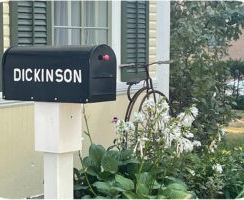Dickinson Square Gardens
DICKINSON SQUARE GARDENS
1127 Mill Street in Manotick
Dickinson Square Gardens: MHS volunteers maintain the gardens on the historical sites of Watson’s Mill, Dickinson House, the Carriage Shed, including a Pioneer Herbs Garden.

Pioneer Herb Garden
This site was built in the early 1980s in the tradition of a pioneer garden. It contains a small sample of herbs the early settlers would have brought with them and grown for their needs as well as several native plants used by First Nations. These plants were used in cooking, as medicine for both humans and animals, and for many household purposes. The pioneers would have had to know a good deal about herbal medicine, since doctors were few and far between. The plants are labeled indicating their common use.
Some herbs in the garden include basil, borage, chives, cilantro, costmary, dill, horseradish, lovage, marigold, marjoram, mint, nasturtium, oregano, parsley, rhubarb, rosemary, sage, summer savory, sweet cicely, tarragon, thyme, wild ginger, and winter savory.
Did you know?
- In addition to attracting pollinators to the garden, borage and nasturtium flowers are a tasty addition to a fresh salad.
- Bergamot or Oswego tea is a First Nations traditional remedy for fever, headache, colds, and sore throat.
- Echinacea, another traditional First Nations herb, is used to treat snakebite and burns. The root has antibacterial properties.

Dickinson House
The building was built in 1867 by Moss Kent Dickinson who was also owner of the grist mill we now know as Watson’s Mill. His family occupied the house for over 60 years. Two other mill-owning families subsequently lived in the house – the Spratts and the Watsons. If you haven’t had a chance to visit the house yet, make a point of going.
The flower beds at Dickinson House contain mainly traditional perennial plants such as delphinium, peonies, irises, echinacea, day lilies, phlox, hosta, lady’s mantle, chelone (turtlehead), lungwort (pulmonaria), astilbe, ferns, roses – Canadian Shield, and many more. There are also spring bulbs such as crocus, narcissus, and allium.
There are picnic tables in the shade and a stage – a lovely place for a picnic or a live music concert.
Dickinson House & Pioneer Herb Garden lead Mary Vallières’s top picks:
- Bloodroot
- Bergamot
- Echinacea
